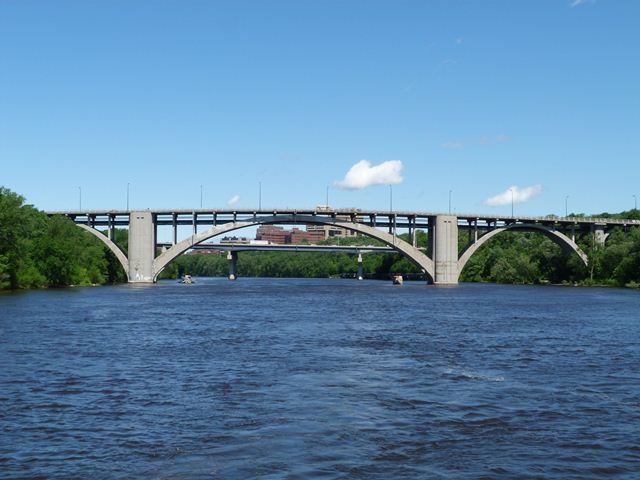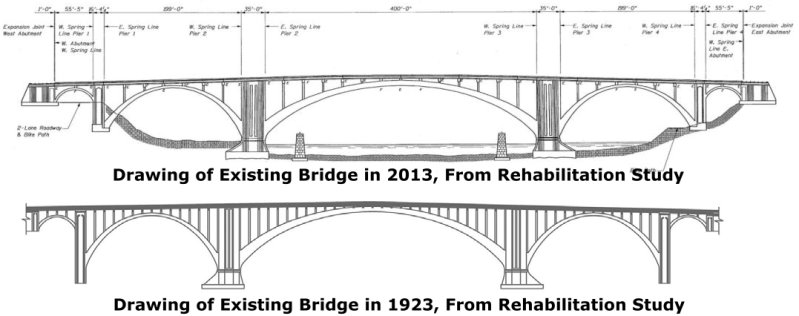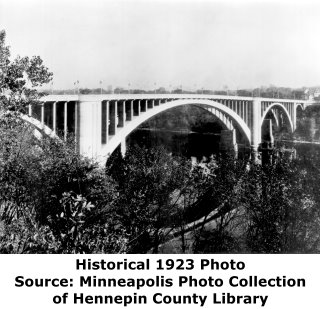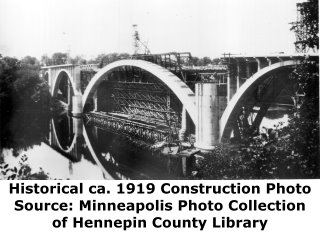We Recommend:
Bach Steel - Experts at historic truss bridge restoration.
Franklin Avenue Bridge
F. W. Cappelen Memorial Bridge

Primary Photographer(s): Nathan Holth
Bridge Documented: May 31, 2013 and June 3, 2013
Minneapolis: Hennepin County, Minnesota: United States
1923 By Builder/Contractor: Minneapolis Steel and Machinery Company of Minneapolis, Minnesota and Engineer/Design: Frederick William Cappelen
1973
400.0 Feet (121.9 Meters)
1,054.5 Feet (321.4 Meters)
50 Feet (15.24 Meters)
5 Main Span(s) and 2 Approach Span(s)
2441

View Information About HSR Ratings
Bridge Documentation
View Archived National Bridge Inventory Report - Has Additional Details and Evaluation
View Historical Article About This Historic Bridge
View The National Register of Historic Places Nomination Form For This Historic Bridge
View A Rehabilitation Study Report That Includes A Historical Overview
View A Historical Biography of Frederick William Cappelen
This bridge is described as a nationally significant historic bridge in the National Register nomination form. This is due to its largest span's clear span of 400 feet, which was the largest in the world when it was completed. The bridge is also noteworthy for its use of Melan style reinforcing, a late example of this early concrete reinforcing method, but perhaps used because it would provide greater stability for the immense span length required. Melan reinforcing uses solid or as in the case of this bridge trussed steel arches embedded in the concrete, as opposed to reinforcing rods (rebar).
This bridge was designed by two noteworthy Norwegian engineers. Frederick William Cappelen was the chief engineer, but died before the bridge was completed, and so assistant engineer Kristoffer Olsen Oustad oversaw its completion. When this bridge was built, it replaced an 1889 metal truss bridge. To maintain traffic, the arches were built around the truss bridge, and when complete, the truss bridge was demolished, the arch bridge completed, and opened to traffic. The on-site contractor is not known for this arch bridge, but Minneapolis Steel and Machinery Company of Minneapolis, Minnesota is shown on the shop drawings for the bridge as the fabricator of the Melan style reinforcing.
This bridge remains historically and technologically significant today because its original arches, in particular, the record-breaking channel span, remain in place. The piers of the bridge with their modest architectural details also remain unaltered. However, everything else above the arches was demolished and replaced from 1971-1973. The original concrete balustrade railing was removed and replaced with a standard plan utilitarian railing. Additionally, a severe alteration that drastically changed the appearance of the bridge was that the original columns were removed and replaced with half as many columns. Replacing the columns is one thing, if they were replaced in kind, but to replace them with a completely different configuration is a severe alteration that drastically altered the visual appearance of the bridge. The bridge looks much more simple and less complex than the original designers of the bridge intended it. With the exception of the shape and length of the arch spans, the bridge no longer conveys the intended aesthetics of its designers.
As of 2013, a rehabilitation is being considered for this bridge. Some of the errors made in 1971 may be corrected, as restoring a replica balustrade railing to the bridge is being considered. Also, the smallest arch span on the bridge, which today only has one column (and thus looks dumb) is to have two columns added, restoring its original appearance. Unfortunately, restoring columns to the other spans is not within the scope of this project. Perhaps in a future project? One unfortunate part of this proposed project is the demolition of the remains of the stone piers of the previous truss bridge which still remain as a testimony to the previous bridge at this location. While in ruins, they are a reminder of the progression of structures at this location, and their loss will prevent future visitors from interpreting this aspect of the crossing history from visiting the bridge.
This bridge is tagged with the following special condition(s): Melan
![]()
Photo Galleries and Videos: Franklin Avenue Bridge
Bridge Photo-Documentation
Original / Full Size PhotosA collection of overview and detail photos. This gallery offers photos in the highest available resolution and file size in a touch-friendly popup viewer.
Alternatively, Browse Without Using Viewer
![]()
Bridge Photo-Documentation
Mobile Optimized PhotosA collection of overview and detail photos. This gallery features data-friendly, fast-loading photos in a touch-friendly popup viewer.
Alternatively, Browse Without Using Viewer
![]()
Maps and Links: Franklin Avenue Bridge
Coordinates (Latitude, Longitude):
Search For Additional Bridge Listings:
Bridgehunter.com: View listed bridges within 0.5 miles (0.8 kilometers) of this bridge.
Bridgehunter.com: View listed bridges within 10 miles (16 kilometers) of this bridge.
Additional Maps:
Google Streetview (If Available)
GeoHack (Additional Links and Coordinates)
Apple Maps (Via DuckDuckGo Search)
Apple Maps (Apple devices only)
Android: Open Location In Your Map or GPS App
Flickr Gallery (Find Nearby Photos)
Wikimedia Commons (Find Nearby Photos)
Directions Via Sygic For Android
Directions Via Sygic For iOS and Android Dolphin Browser
USGS National Map (United States Only)
Historical USGS Topo Maps (United States Only)
Historic Aerials (United States Only)
CalTopo Maps (United States Only)






